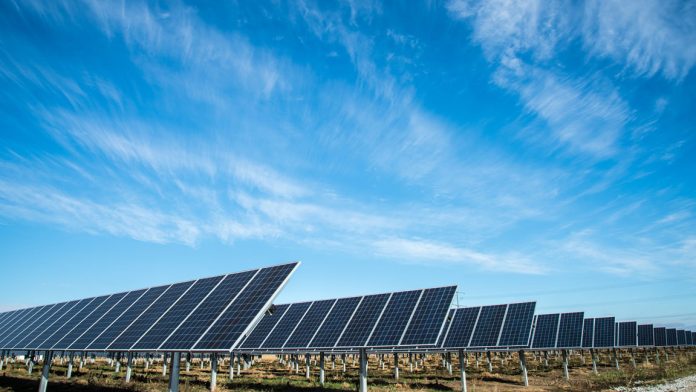With the US and global economy in free-fall due to the COVID-19 pandemic, the renewable energy industry is hemorrhaging projects and jobs at a faster rate than the overall economy. As of the end of April, more than half a million US clean energy workers are now out of work, and the number is still climbing. What is increasingly clear is that if we don’t take immediate action to stem the bleeding, the US will lose a big chunk of what was one of the fastest growing sectors of our economy and, in the long term, could also have a serious setback in efforts to address climate change.
The Solar Energy Industries Association (SEIA) is projecting the US solar industry will lose nearly 114,000 jobs through June, representing 38 percent fewer jobs than the pre-COVID-19 forecast, according to new analysis released today. Instead of growing from a base of 250,000 jobs at the end of 2019 to 302,000 jobs (as projected), SEIA is now projecting total US solar jobs to fall to 188,000 by the end of June. This would negate five years of solar industry job growth.

Source: based on data from SEIA, May 2020.
SEIA is also projecting that solar power construction in the second quarter of 2020—from April to June—will be 1,725 megawatts (MW) less than expected, representing a 35 percent drop from its pre-COVID forecast. These Q2 solar deployment losses are equivalent to the US losing the capability to power 288,000 homes and represents $3.2 billion in lost economic investment, SEIA says.
Some states are being hit much harder than others
A whopping two-thirds of the total solar job losses across the country – a total of 76,439 jobs – are driven by unemployment filings in nine US states. States experiencing the greatest number of solar job losses include: California (35,687), New York (9,053), New Jersey (5,726), Texas (5,106), Florida (5,617), Massachusetts (4,284), Arizona (4,002), Illinois (3,742) and Pennsylvania (3,222).
The states experiencing the largest job losses as a share of total solar employment include New York, Washington, New Jersey, New Hampshire, Pennsylvania, Connecticut and Idaho. These seven states plus Washington D.C. are projected to lose 60-75 percent of their solar jobs through June, while 21 states will suffer job losses exceeding 40 percent and 36 states will see job losses exceeding 30 percent.

Source: SEIA, May 2020.
Solar is not the only renewable energy source experiencing job losses from COVID-19. The American Wind Energy Association (AWEA) has also estimated that COVID-19 has put 25 gigawatts of US wind projects at risk, representing 35,000 jobs, $35 billion in investment, and $8 billion in tax revenues and land lease payments for state and local economies.
Keeping jobs, keeping workers safe
Jobs in solar, wind and other renewable energy technologies are good, high quality jobs that are worth preserving. The solar industry employs a wide range of occupations including installers, electricians, salespeople, project developers, financiers, and workers that manufacture solar panels and other components.
More than half of total solar jobs in 2019 were in the residential sector. COVID-19 is hitting this solar market segment the hardest because of shelter-in-place orders, social distancing, local permitting delays, and the significant financial uncertainties many families are currently facing. It is also having a disproportionate impact on smaller local solar companies, who are having a much harder time weathering the financial storm than larger companies.
As states start to ease restrictions and gradually re-open, it is essential that all workers, including renewable energy workers, are protected the virus when they return to their jobs. Unfortunately, the Trump Administration and most states have not put sufficient regulations and standards in place to ensure these vital protections.
Putting the renewable energy industry back to work
With the right policies, the renewable energy industry can play an important role in helping the US economy recover from the recession, putting thousands of Americans safely back to work. Here are three common-sense actions Congress can take:
- To better protect the workers who have continued to work during the crisis or will soon come back to the job, Congress must require that the Occupational Health and Safety Administration (OSHA) immediately institute a temporary emergency standard that requires employers to ensure their workers are protected from the virus.
- To stem recent job losses, Congress also should provide immediate relief for the renewable energy industry in the next stimulus bill by extending safe harbor provisions for the production tax credit (PTC) and investment tax credit (ITC) and temporarily providing direct cash payments in lieu of the tax credits until the economy recovers. The IRS recently indicated they will modify the rules for the safe harbor provision “in the near future” in response to an April 23 bi-partisan letter from the chairs and ranking members of the Senate Finance and Energy and Natural Resources Committees to Treasury Secretary Steven Mnuchin. The Senators called for the safe harbor deadlines to be extended by 12 months, from four to five years for projects that began construction in 2016 and 2017. While this news is promising, the IRS has not provided any details on what changes they will make to the rules and current economic stimulus proposals in Congress do not include these provisions.
- To ensure that the renewable energy industry is able to recover over the longer-term and play a vital role in creating jobs and addressing climate change, UCS and other groups are calling on Congress to extend the ITC and PTC by at least five years and expand it to include stand-alone energy storage. These proposals are also supported by many members of Congress.






